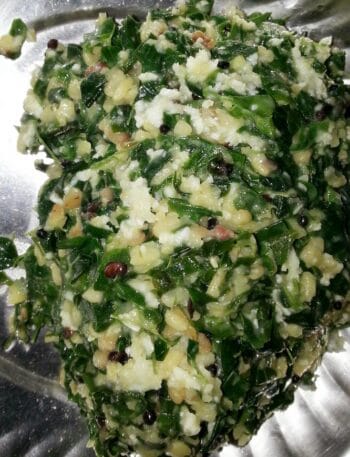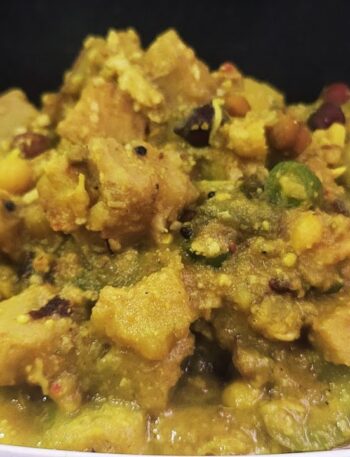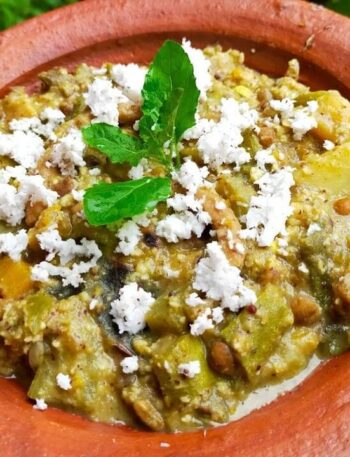Origin and Cultural Significance—
Did you know that a simple bowl of Poi Ghanta carries centuries of Odisha’s rich agricultural heritage and culinary traditions? This humble rural dish is a staple food in many Odiya households. This dish reflects the region’s deep connection with locally grown ingredients and sustainable cooking practices.
The name “Poi Ghanta” is derived from the Odia words “poi,” referring to Malabar spinach, and “ghanta,” which means mixed curry. The ingredients, such as Malabar Spinach, Seasonal vegetables, and lentils, reflect the historical practice of using seasonal produce and are often prepared during festivals, family gatherings, and temple offerings. They are celebrated for their rich flavours, unique textures, and deep cultural roots.
A Dish Steeped in Tradition & Community Bonding—
In Odisha, food is more than sustenance—it reflects community and tradition. Poi Ghanta, in particular, holds a special place in harvest festivals and temple rituals.
🌾 A farmer’s delight: Traditionally, this dish was made using freshly harvested spinach and seasonal vegetables, making it a sustainable and cost-effective meal.
🏡 A household favourite: It is commonly served during family gatherings, symbolising sharing and nourishment.
🛕 A part of temple offerings: Many Odia temples prepare variations of Poi Ghanta as a sattvic (pure) dish, free from onion and garlic.
How to Make Poi Ghanta at Home—
✔️ Pressure Cooker – For cooking the lentils (Arhar Daal)
✔️ Pan or Kadai – For sautéing vegetables and blending flavours.
✔️ Knife & Cutting Board – For chopping fresh ingredients.
✔️ Spatula – For mixing and stirring.
🥘 Ingredients:
🟢 Malabar spinach – 250g (poi saag), chopped
🟡 Arhar Dal (Split pigeon peas)– ½ cup soaked
🥔 Potato – 1 peeled and diced
🧅 Onion – 1 finely chopped
🌶 Green chillies – 2-3 chopped
🧂 Mustard seeds – 1 tsp
🧂 Cumin seeds – 1 tsp
🧂 Turmeric powder – ½ tsp (Haldi)
🧂 Red chilli powder (Sukhi mirch powder) – ½ tsp
🧂 Salt – to taste
🥄 Oil – for cooking
💧 Water – as required
Step-by-Step Cooking Instructions—
Get the ingredients ready:
- First, rinse the Arhar Dal thoroughly and soak them for 30 minutes. While the dal is soaked, finely chop the Malabar Spinach, Onions, Chillies, and Potatoes into small even pieces.
Cook the Lentils:
- Add 2 cups of water to a pressure cooker, then add the soaked lentils. Give 2-3 whistles until soft but not mushy.
Saute the Spices & Vegetables:
- Heat some oil in a separate pan and add cumin seeds and mustard seeds. Let them splutter.
- Add chopped green chillies and onions. Sauté until the onions turn soft and golden brown.
- Stir in the Malabar Spinach and potatoes, mixing everything properly so that all the ingredients are well coated.
- Sprinkle in a pinch of Turmeric, Salt & Red chilli powder to enhance the flavours.
Combine & Simmer:
- Once you saute the vegetables, add the cooked lentils and mix thoroughly.
- Add water to adjust consistency
- Cover the pan and let it simmer on low heat for about 10-15 minutes so the flavours meld together.
Final Touch & Serving:
- Taste and adjust the seasoning if needed. For added richness, drizzle a teaspoon of ghee on top before serving.
- Enjoy with Hot steamed roti or Rice, Traditional pitha- whatever you like best.
Best Ways to Enjoy Poi Ghanta—
🌾 Traditional Pairings:
✔️ Steamed Rice – Brings out the natural earthiness of the dish.
✔️ Dalma (Lentil & Vegetable Stew) – A classic Odia combination.
✔️ Pickle (Achaar) – A tangy pickle can add a burst of flavour to the dish.
✔️ Fritters or Bhaja (Fried Vegetables) – Crispy, spiced vegetables add texture.
🍹 Beverage Pairings:
✔️ Buttermilk – Soothes the palate and aids digestion.
✔️ Sattu Drink – A protein-rich drink commonly consumed in Odisha.
✔️ Lassi – A refreshing sweet or savoury yogurt-based drink.
🍮 Desserts for a Sweet Ending:
✔️ Chhena Poda – Odisha’s famous caramelised cheesecake.
✔️ Rasgulla – The iconic soft, spongy delight.
✔️ Coconut Ladoo – A sweet, melt-in-the-mouth delight made in minutes
Storage & Leftover Tips—
- Store in an airtight container in the refrigerator for up to 3–4 days.
- Reheat gently on the stovetop with a splash of water or in the microwave before serving.
- Avoid freezing, as spinach may become watery and lose its texture.
- It is always a good idea to check for any signs of spoilage before consuming leftover dishes, especially if they have been stored for a few days.
Health Benefits of Poi Ghanta—
- Poi Ghanta is a nutritional powerhouse. Lentils are high in plant-based protein, which is essential for muscle growth and repair.
- It is rich in Fibre, helps in weight management, aids digestion and promotes gut health.
- Malabar Spinach is loaded with Vitamins A and C, Iron, and Calcium, which are good for immunity, vision, and bone health.
- A perfect dish for weight management, low in calories, when cooked with minimal oil.
- Lentils and spinach contain antioxidants that reduce inflammation and improve cardiovascular health.
A Dish That Embodies Odisha’s Culinary Soul—
Poi Ghanta is more than just a recipe — it tells a story of tradition, sustainability, and community. From its beginnings in rural kitchens to its place in contemporary Odia cuisine, this dish exemplifies the beauty of simple, locally sourced ingredients.
Next time you prepare Poi Ghanta, enjoy its rich flavours and remember the generations of cooks who have lovingly passed down this recipe.
Craving More? Try These Malabar Spinach Delicacies!
Malabar spinach (Poi Saag) is incredibly versatile, allowing you to create many more dishes with it. Explore these traditional Odia recipes that highlight their unique flavour and nutrition:
Poi Besara – Malabar spinach cooked with mustard paste and seasonal vegetables.
Chana Poi Tarkari – A hearty curry made with Malabar spinach and black chickpeas.
Poi Chingudi Jhola – A flavorful curry of prawns and Malabar spinach.
Poi Patra Pitha – Steamed rolls of Malabar spinach stuffed with a spiced lentil mixture.
Poi Saga Bhaja – A simple stir-fry featuring garlic, mustard seeds, and chillies.
(Recipes coming soon — stay tuned!)
Click on the links above to discover more delicious ways to enjoy Poi Saag!
Let us know in the comments which one is your favourite. 😊





